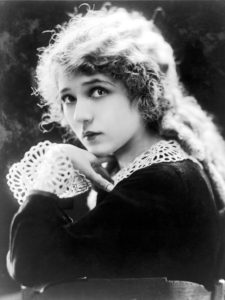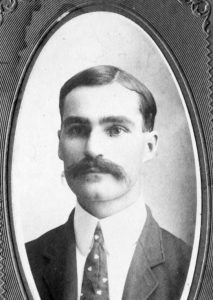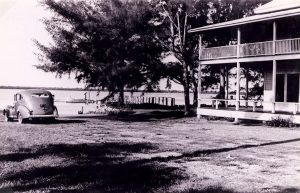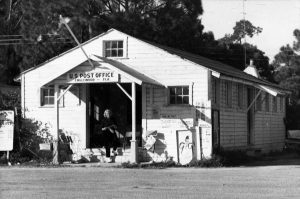Englewood History
LEMON BAY HISTORICAL SOCIETY
TOUR OF HISTORIC ENGLEWOOD
LOCAL HISTORY BOOKS
HISTORY: OLD ENGLEWOOD VILLAGE
ENGLEWOOD MUSEUM
ENGLEWOOD FLORIDA HISTORY
BUCHAN AIRPORT: FROM MOVIE STARS TO MOSQUITOES
(Compiled and edited by Don Bayley)
During the heyday of land speculation in the 1920s, a development of 98 acres was planned for west of today’s Old Englewood Road, right where Buchan Airport is today. Designed as a Mecca for vacationing stars and the wealthy, it was to be called Hygeia. Douglas Fairbanks and Mary Pickford planned to build their 30-room home here.

“Close on the heels of the announcement that a half score of producers, managers, actors, newspaper men and authors had purchased lots in Hygeia, the latest development in Englewood, is the news that Mr. and Mrs. Douglas Fairbanks have also made purchases here.” —Sarasota Herald
When the Great Florida Land Boom suddenly ended, Hygeia was all but forgotten; the land sat unused for many years. But in 1949 a new development came to the area due to a very influential player in Florida’s history: the mosquito.
In the 1940s malaria was still fairly common in Sarasota County. It wasn’t until the 1900s that the link between disease and the mosquito was discovered. The County formed a new mosquito eradication program and in April 1949 Sarasota Commissioner Peter E. Buchan helped the County acquire 93 acres of the Hygeia land for just $100. This was to build an airport to facilitate aerial spraying. The County Commissioners named the airport to honor Peter E. Buchan’s “long and efficient service to the county.”
In the 1960s, homes with hangers were built along the only remaining street from Hygeia, Osceola Road. Today Buchan Airport is operated by the Sarasota County Board of County Commissioners.
WHO WAS PETER E. BUCHAN?

Born in Georgia in 1871, Peter (“Pete”) Buchan (pronounced Buck-an) and his wife Florence arrived in Englewood in 1902. Pete first worked as a bookkeeper for the Chadwick Fish Company. In 1908 he worked at the town’s only store owned by the Nichols brothers who founded Englewood(1). When business came to a standstill, Pete left the area but returned in 1912. As soon as he entered the store (on Yale St.) H.K. Nichols exclaimed, “Hi. Have you come back to buy the store?” It was an offer Pete couldn’t refuse. He got the business and the entire inventory for $315!
In 1913, for $100, Pete Buchan bought all of the bay-side land at the corner of Dearborn and Olive (now Old Englewood Rd). He built a new 2-story building and moved the store there from Yale Street. He and his family lived on the second floor. He also built a 250-foot pier out into Lemon Bay. All supplies came into Englewood by boat to “Buchan’s Landing.” The name and the building still exist today. (See photo below.)
Always active in the growing community, Pete organized a work group to open up Blind Pass. He was appointed Englewood Postmaster in 1912 and set up a Post Office in his store. He served as a Trustee for the Englewood School District. In 1921 he was appointed by Governor Cary A. Hardee to be the first Sarasota County Commissioner from Englewood. Buchan served for 21 years and was instrumental in having a paved road connecting Englewood with Sarasota.
Peter E. Buchan died in 1968 at the age of 97.
(1) In 1893 three brothers from Englewood, Illinois: Herbert, Howard and Ira Nichols saw an exhibit at the Columbian Exposition in Chicago which introduced the idea of growing lemons in Southwest Florida. At the time scurvy was still a very serious problem. Lemons were the prescribed treatment but had to be imported from Spain which was very costly. Grove City was already underway and an unnamed bay was christened “Lemon Bay.” It was thought easy money could be made by growing lemons in Florida.
The Nichols brothers figured they could cash in on the lemon trend by selling building lots, each with an additional 10 acres on which to grow lemons. They founded Englewood, named after their home-town in Illinois and set to work selling lots. But the extra cold winters of 1894 and 1895 killed all the lemon trees.
Undaunted, the brothers changed their focus to building a Mecca to attract wealthy tourists to the area. They built the Englewood Inn (at the end of Perry St.) and started a general store (on Yale St.). But in 1909 the Inn burned to the ground. They tried to keep the store going on Yale Street but were down on their luck and down on their funding so it’s no wonder they were delighted to sell the store to Peter Buchan at such a bargain price.
(SOURCES: Florida Mosquito Control District website, keysmosquito.org; Diana Harris, Englewood Lives; Newton Studios, Englewood, the First 100 Years; Lindsey Williams, Writer At Large, Sun Coast Media Group; Buchan Airport website, buchanairport.weebly.com)

Dearborn Street:
Dearborn Street began as a path and oxen trail worn by the William and Mary Goff family that moved to Lemon Bay in 1878. When Herbert, Howard, and Ira Nichols platted Englewood in 1896 they used the trail as the southern boundary of the residential area. They named it Dearborn.
In 1912 Peter and Florence Buchan purchased from the Nichols brothers the only supply business in town, along with the rights to the post office, for the sum of $315. The following year they acquired land on the corner of Dearborn Street and (now) Old Englewood Road. On it they built a two-story building with the store and post office located on the first floor and the family´s living quarters above. The Buchans also built a dock that extended 250 feet into Lemon Bay and became the arrival point for goods coming into town. (There were no roads connecting Englewood with other communities at that time.) Almost immediately, the property became known as Buchan´s Landing. Other merchants soon followed Buchan´s lead and Dearborn Street became the new commercial center of Englewood.
Side 2:
During the rapid growth period of the 1920s, Dearborn Street was part of the initial route for the Tamiami Trail. In spite of promises at the highway´s 1928 opening that Englewood would always be on the route, by the mid-1930´s it has been bypassed.
Englewood´s oldest building remains at the corner of Dearborn Street and Old Englewood Road. It was built in 1896 and became Mrs. Quimbly´s Boarding House for Ladies and Gentlemen. In more recent years it was Rinkard´s Guest House.
Dearborn Street has been the location of a number of “first” for the town. Dr Ernest Smith was the first doctor and Dr. John Flower the first dentist. Englewood´s first newspaper, The Englewood Herald, the first 5&10 store, funeral home, appliance store, playhouse theater, drug store and outboard motor repair shop were located on Dearborn.
Set back from Dearborn is the Elsie Quirk Library, the first community library to receive funds from Sarasota County Government. In the 1990´s, civic and government leaders began a program to revitalize historic Dearborn Street.
(Text from Historic Marker, Corner of Dearborn and Mango Streets)
Englewood Post Offices:

In 1946 the Post Office was in an Army surplus barracks building which was moved from the Venice Air Field to the corner of Dearborn and Elm Streets (where Vino Loco is today).
Englewood Post Offices Span 113 years
—By Ken Kocab
Since August 18, 1896 , Englewood residents have been served by a local post office. Mail for the few permanent residents of early Englewood was brought to El Jobean by boat from Punta Gorda. Local resident Wilbur Lampp then loaded the mailbags onto his horse, and made the ten mile ride to the Englewood Post Office. This first post office was located in the back of the Lemon Bay Trading Company on Yale Street.
John S. Gibbons was Englewood’s first postmaster and initially operated a 4th class operation. The government designated ratings for all post offices based on the volume of mail and sales at each location. From 1896 to 1916 eight different postmasters oversaw day-to-day operations at the Yale Street location.
In 1912, local resident Peter Buchan was hired as caretaker of the Lemon Bay Trading Company, at the same time he also appointed Englewood Postmaster. By 1916 Buchan built his own store at the intersection of Dearborn and Olive Streets on Lemon Bay. Buchan then moved the post office to the new store, and remained postmaster until 1921, when he gave up this position to his wife Florence.
During the years Florence Buchan was postmaster, business seemed to slow down. “On a good day we sold stamps for about six letters,” said Buchan. Postal authorities noticed the situation and threatened to close down the Englewood branch. Local residents organized and began mailing grapefruits to each other to increase the volume of mail. This plan seemed to succeed, and the Englewood post office continued to operate.
In 1928, the post office was moved from Buchan’s Landing, to Ziegler’s General and Hardware Store on Dearborn Street. Mary Green was appointed new postmaster that year, and in 1929 totaled $1,200 in postal receipts at the Ziegler Store location. Because of this increase, postal authorities raised Englewood to a 3rd class operation.
The post office remained at the Ziegler Store until 1946, when an Army surplus barracks building was moved from Buchan Field to the corner of Dearborn and Elm Streets. This structure was converted into a post office, and for the first time, Englewood had a post office housed in its own building. There was no mail delivery at this time, so the new building housed over 400 boxes for people to come in and pick up their mail. In 1951, postal receipts climbed to over $8,000 a year.
By 1959 , the Englewood Post Office on Elm Street definitely needed more space. It was at this time a new location was found in the former Sears store on Dearborn Street, across from the old hardware store. The old location on Elm Street was torn down. In 1961 Florence Johnson was appointed postmaster and remained in this position until her retirement in 1980. Johnson was responsible for modernizing Englewood’s post office operations. By 1962 the Englewood branch had collected over $56,000 in receipts and was finally designated a 1st class operation. Florence initiated Englewood’s first home delivery and even formulated the routes that carriers would take. One big problem for mail delivery was the lack of street names and house numbers. Florence organized a very successful effort for residents to put up house numbers, and for street signs to be put in place. By 1970, postal receipts at the Dearborn Street location had reached $200,000, and space was once again a problem. A large modern post office was built on River Road with plenty of room for parking. Englewood post office operations are still run from this location today.
After having a post office in the heart of Englewood ever since 1896, currently there is none located in the Olde Historical Village. Betty Nugent, President of SHORE, (Southwest Historical Organization Resources Education) and local activist, feels the current River Road Post Office is fine, but that a satellite version in the Historical Village would be helpful for local residents. “We need our post office back to serve both the older and newer generations in Englewood,” said Betty.
I would like to credit the following sources in writing this article:
Betty Nugent, Interview, 5-7-09
Josephine Cortes Speech given on Englewood History, 1961.
“Florence Johnson was Englewood’s Longest Serving Postmaster”, by Diana Harris, The Englewood Sun May 9, 2009